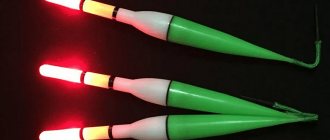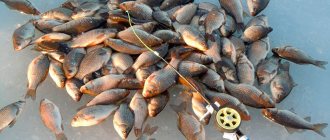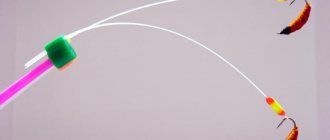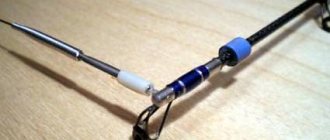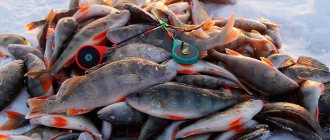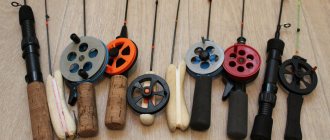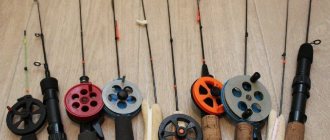The more you master the topic of winter fishing, naturally, including its equipment, the clearer the presence of its specific features becomes. But the biggest change was the float fishing rod with floats. In this matter it is very important to ensure maximum float sensitivity. After all, it is necessary that he signal even the lightest and most inconspicuous bite, without in any way resisting it. Because this behavior can scare away the fish.
Below are the types of winter floats:
Winter float equipment
Ice fishing rods with a float are the main winter gear for many anglers. Beginner ice fishermen usually choose this particular gear for their first acquaintance with winter fishing. Inexperienced fishermen often make the mistake of not taking into account the fine-tuning features of their gear. A float for winter fishing in the correct equipment is loaded slightly more than its carrying capacity. If you hang a very heavy load on a light float, then the principle of compensating for the weight of the bait will only partially work. Only a small part of the weight corresponding to the carrying capacity of the float will be compensated for when taking a bite on the rise during the ascent.
The float cannot take more bait weight than its rated carrying capacity. Therefore, the size and carrying capacity of the under-ice float in the correct installation option should be matched to the weight of the equipment so that the entire mass of the working part slowly sinks it, and not drags it to the bottom like a stone. A heavy jig on a light float will work when the fish bites greedily and boldly, for example, on the first or last ice. However, in the middle of winter, a sluggish fish will simply immediately spit out the bait, mistaking it for a foreign, inedible object. Read more about proper rigging of fishing rods in winter. In this article, we will take a closer look at the floats themselves for winter fishing, their types and features of use.

Preparing bait for winter fishing
As soon as bodies of water with a large abundance of grass, such as lakes, are covered with ice, the jig sticks to the lower edge of the ice, where it is collected.
3 ways to improve your fish bite!
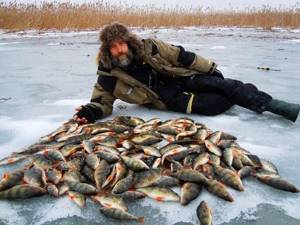
Over 15 years of active fishing, I have found many ways to improve the bite, and here are the most effective:
1. Bite activator . This pheromone additive attracts fish most strongly in cold and warm water. The Fish Hungry bite activator has proven itself to be excellent - Read more…
2. Tackle with increased sensitivity . You should first familiarize yourself with the features of using a particular type.
3. Pheromone baits . They attract the attention of fish, stimulate hunger and cause a schooling reflex, which allows you to collect a lot of fish in one place.
You can get the rest of the secrets of successful fishing for free by reading my other materials on the site.
3 ways to improve your fish bite!
Over 15 years of active fishing, I have found many ways to improve the bite, and here are the most effective:
1. Bite activator . This pheromone additive attracts fish most strongly in cold and warm water. The Fish Hungry bite activator has proven itself to be excellent - Read more…
2. Tackle with increased sensitivity . You should first familiarize yourself with the features of using a particular type.
3. Pheromone baits . They attract the attention of fish, stimulate hunger and cause a schooling reflex, which allows you to collect a lot of fish in one place.
You can get the rest of the secrets of successful fishing for free by reading my other materials on the site.
Mormysh should be stored in a basement or cellar, most importantly in a cool place, placed in a wooden box and covered with a cloth.
Mormysh is kept alive in this state for a long time. And you can get it throughout the winter. On frosty days, when catching mormysh, it should be wrapped in rags, and when fishing, take it in a wooden box and store it in your pocket or in your bosom.
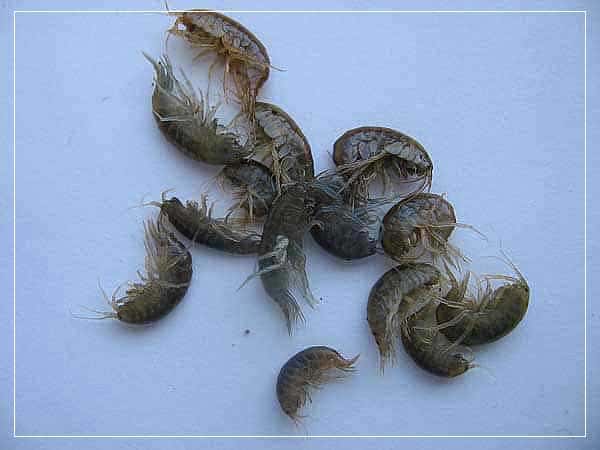
Getting worms in winter is quite a big problem. It is best to prepare them, of course, in the fall and store them in the basement in a box with soil, sometimes feeding them with cold potato broth, curdled milk, or slurry.
Sometimes you can find worms in winter under the floorboards in a village bathhouse or in large barnyards in manure.
Using an animal bait when fishing in winter gives a positive result not only when fishing with a winter float rod, but also when trolling and when fishing with a jig.
Baits of animal origin can be very different, but most winter fishermen use the following for this purpose:
Bloodworms (large and small);
Burdock larva;
Maggot;
Worm;
Mormysha.
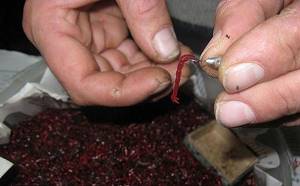
Fishing success can depend not only on the type of bait used, but also on how it is placed on the hook. For example:
Large bloodworms are usually dressed in a half-ring;
The burdock is simply pierced through (usually 2–3 larvae are planted).
Quite often in practice it is used - “sandwich”: burdock with bloodworms - first the burdock is planted, then the bloodworms. With a weak bite, small bloodworms show good results, however, the thinnest and well-sharpened hooks are required to attach them.
Some anglers even successfully use artificial baits - colored rubber, cambric, beads, etc., but most still prefer to use bait of animal origin.
Composite floats
For deep fishing and sensitive fishing rods with a sufficiently large weight of the bait (sinkers), it is more practical to use composite modifications. An ordinary ball or egg is less sensitive - you need to catch it during the ascent. Otherwise, when the alarm has already risen completely out of the water and lies on its side, the compensation will stop working and the fish will feel a “pebble” (jig) in its mouth or the pressure of the bait on the lower lip.
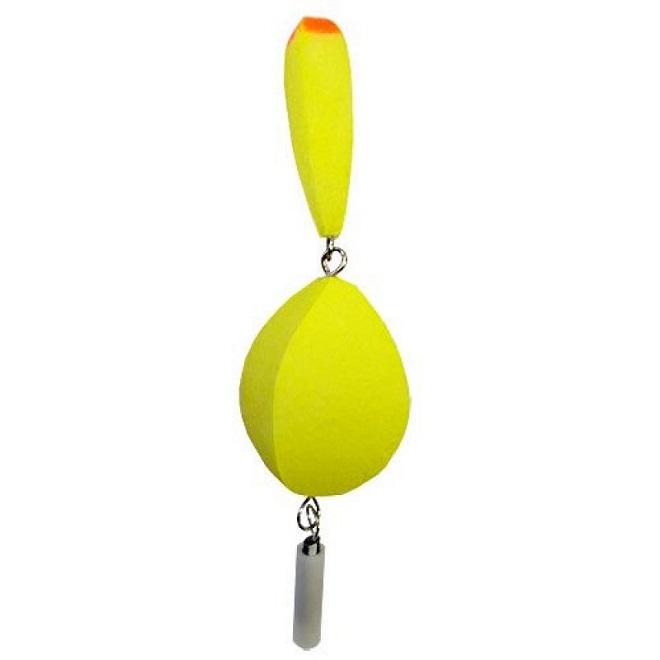
Double compound
Such floats in winter are more convenient for catching bream or crucian carp from the bottom - the principle of weight compensation continues to work when one small upper part floats to the surface. Large bodies are still in the water and continue to take the weight of the load upon themselves. The fish is just beginning to lift the bait from the bottom, and the subglacier already knows about this, observing the upper small body of the fish emerging from the water. The components are a set of foam bodies connected by loops. The largest body is located at the bottom, and then up in descending order. The fastening method is usually pinned through a cambric. Such products can be double, triple or more.
A similar effect can be achieved by mounting with two floats. The larger one is located in the water below, at a distance of half a meter from the small one, the signal one. When biting, only the signal one floats up completely, and the main one in the water continues to take the weight of the bait onto itself. Such installation requires careful loading, preferably at home in advance. For more details, follow the link at the beginning of the article about winter float installations.

Team member in working position
Flowers, roses, daisies
If the classic winter composition has obvious functionality (compensation), then these representatives have more of an artistic direction. Well, some subglaciers like their beautiful bloom when biting on the rise. Such floats for winter fishing in the form of daisies and tulips are beautiful, but they suffer from some disadvantages. Many components on the hinge are easily vulnerable, freeze to the ice and come off. Such products require the fisherman to be extremely careful in their work. In terms of functionality, there are no special differences from the standard. The flower simply beautifully spreads its blades when surfacing, partially compensating for the weight of the bait, like a compound (if a sufficiently voluminous body remains under water after rising). Read more about winter floats and flowers.
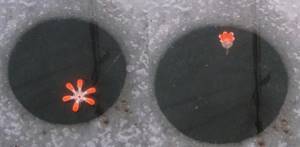
Four types of winter floats and their fastenings
The figure shows four types of fastening winter floats to a fishing line.
Difficult to replace
1. Float with an internal channel for fishing line. Disadvantage: to change the float you need to break the line. Advantage: tight attachment to the fishing line.
2. Float with fastening at the lowest point. If the float does not have a ring, then it is easy to change it to another one, but if during rigging the fishing line is threaded into the ring, you will have to tear the fishing line to change to another float.
Easily replaceable
3. The float with a side slot is very convenient for quickly changing to another float.
4. Float with removable antenna.
Loading
As already noted, the most important thing in installing a winter float is selecting the weight of the equipment. Or vice versa - selecting the carrying capacity for a specific jig. If in a hook rig the weight can be adjusted with pellets, then you can’t do anything with a jig if it is too heavy. The solution is to experiment with floats of different carrying capacities. Or make a homemade one purely for this jig, grinding the foam to the required load-carrying capacity. The correct equipment barely sinks, but floats when the fish touches the hook. The overall buoyancy of the system should be slightly negative as a result of the adjustment.

When there is a bite on the suspension, the alarm dives or moves to the side - here compensation is no longer important. Read more about winter mounts for fishing rods. For fishing in the water column, loading is done in summer style. The foam floats in the hole and holds the equipment in the water column at the required horizon. However, in severe frosts such equipment freezes into the ice. Nodding winter equipment is more suitable for this.
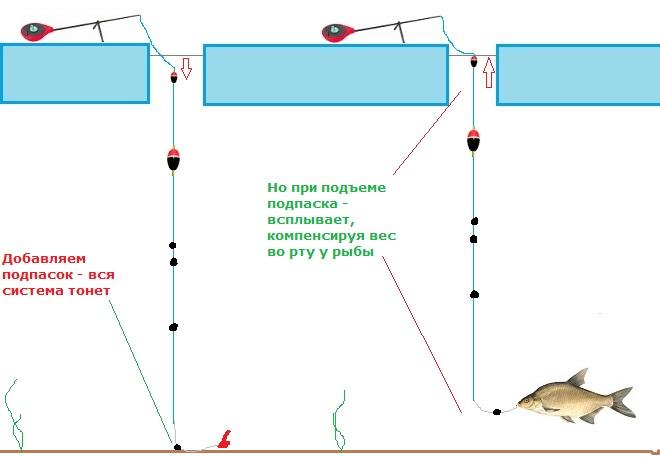
Fishing technique and tactics
When fishing, much fewer holes will be drilled than when fishing with a jig. Be sure to have a comfortable box for sitting, or even better, a tent. You can fish from a soft mat or sled, but when fishing from your knees, your legs will get tired from kneeling in one place for a long time.
First, the angler drills several holes and checks the depth. In your arsenal you need to have at least five or six fillies with preliminary settings for different depths - so that you do not need to reconfigure them too much and you can only tighten the float a little. It is advisable to sign the fillies by numbers - from the smallest depth to the largest. Then they sit near the hole and wait for a bite. If it’s not there, go to the next one.
A feeder and a depth gauge are the float angler’s best friends. When fishing with a float, you can’t immediately understand whether there will be a bite from this hole; more time is spent than when fishing with a jig. Therefore, initially it is worth taking places at the beginning and end of the dumps, where an interesting bottom, pits on a flat area are determined by tapping. It’s better to drill a couple of dozen holes at the beginning than to start fishing from the first and waste the whole day. Only interesting holes are fed, and not all, and this must be done wisely, without overfeeding the fish, using animal components.
If there is a bite, they stay here and drill a couple more holes, laying out an additional two fillies without numbers, setting them to the appropriate depth initially. At the same time, they look at the float of the first fishing rod: if it bites, we pull it out. An interesting detail: you should not sweep away the crumbs around the hole; it will serve as a natural support for the fishing rod. You need to slam it down a little with a scoop, creating an ice mound of small height.
Read: Winter fishing. Fish bait
This is necessary so that the fish cannot drag the fishing rod into the hole, so that it is initially rested against an obstacle. In the old days, for this they used an ice pick placed in front of the holes, which was used to chop the ice; now they use an ice drill, which is much more convenient. When biting a large fish that has caught itself, a fishing rod being dragged under the water is not that uncommon.
Bait can affect fishing success, but not always. Usually the fish stay in their “winter quarters” and it is quite difficult to lure them to some other place. It is easier to find a good place by drilling additional holes. It is advisable to drill them when searching every ten to fifteen meters, then, when there is a bite, you should drill a few more around the “successful” one, perhaps in some of them there will be a more active bite. There is usually no point in leaving this place.
At first, when there are no bites and the fish have not yet been found, you can sit on one hole for about 10-15 minutes. Then, when the fish is found, the place of more active biting also sits until the end of the day. The fish bite occurs throughout the day with varying success, a school approaches, begins to take, and after the bite there follows a certain lull. You only need to weigh anchor and go searching further if nothing has bitten for a couple of hours. At the same time, it’s worth looking at other fishermen - if they are biting, but here everything is gone, you should go in their direction. Even if they catch perch with spinners, they can just as well catch it with a float with a butterfly, no worse than with a spinner.
Pulling out fish from great depths is done using a “mill” - the fishing line is selected by winding it around your arms spread out to the sides. You should not throw the filly aside at the end - snow sticks to the reel, which makes it difficult to use; quite rarely, it can break through the crust and get stuck; it is better to place it near the hole on a smooth surface. A thicker fishing line for a float tangles much less than an ultra-thin jig. When actively biting with three fishing rods, it is important to quickly be able to pull out, remove, replant and release the fishing line into the hole, then pull out the next one. Often the fish won’t even let you put out the second fishing rod.
Playing along is another element that allows you to catch more. The rod is taken in the hand, then one or two swings are made with a large amplitude - from 30 cm to a meter. At the same time, the nozzle smoothly lowers down, attracting fish. You should not use this technique too often - perhaps the fish has already approached and is sniffing, and then the bait flies up from under its nose when the fisherman decided to play along with it a little more. Everything has its time, you need to have patience when fishing like this.
Homemade products
In fishing stores you can find winter floats of any configuration, size and color. However, often fishermen make floats for ice fishing with their own hands. There is nothing complicated about it. A blank is machined from solid foam, then adjusted with a file or sandpaper to the required size.
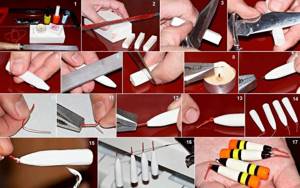
DIY production according to Salapin (click to enlarge)
The advantage of this activity is that you can prepare any necessary sizes and shapes. The blank is painted with water-based acrylic paints or women's nail polish. The main thing is to choose paint so that it does not corrode the foam. It turns out no worse than in the store in appearance, but with the required load capacity and size.
Subscribe to the channel:
My YouTube channel RYBAFAN on fishing:
We're OK
Making a homemade winter float
A homemade float may be no different from a purchased one, and in some cases even surpass the latter, because you can make a winter float really sensitive, which floats from store shelves cannot always boast of.
- To make a float with our own hands, we will need hard (dense) foam plastic; from it we need to cut blanks for the future float (of course, with angular edges for now). The larger the size of the float, the higher its carrying capacity. After receiving the first workpiece, you can try testing it in a jar of water to see how much weight the workpiece can withstand in order to determine the size of future floats.
- The blanks have been received, now you need to shape the float using a knife, removing all excess.
- To give a smooth surface to our almost finished float, it can be sanded with fine sandpaper or a file.
- We need to make fastenings at the bottom of the float. First, we melt a hole with a hot needle or pin, then we make a fastening from a wire, for example from a telephone wire or from anything, here you just need to use your imagination.
- After inserting the fastener, if you are not sure of the strength of the connection with the workpiece, apply a drop of glue to the joint.
Making a winter float is a creative activity; now, if you want, you can prime the float with a primer, and then, when it dries, paint the top or, conversely, the bottom of the float in the colors you want. It is necessary to prime the float so that it does not absorb water and paint.
The process of fishing with a float rod in winter
- The hook catches the bait.
- The tackle is lowered into the hole.
- After the sinker reaches the bottom, the float moves along the line so that it is under water at a distance of 1-2 cm from the surface.
- When bitten, the float may sink even deeper into the water, begin to move from side to side, or float up.
- At the slightest suspicion of a bite, it is necessary to make a sharp, but not strong hook, so as not to break the thin fishing line.
The winter float rod consists of:
- fishing rods;
- fishing lines;
- float;
- hook or jig (you can combine them in any order, focusing on the characteristics of a particular body of water);
- sinkers.
The most popular designs of winter fishing rods are the following:
- "Filly." Usually a homemade fishing rod made of hard foam and a durable whip. The legs of the “filly”, on which it stands on the ice, are also a reel for storing a supply of fishing line.
- "Balalaika". A universal fishing rod, used by both jigs and floaters, provided, of course, that it has legs to place it on the ice. The reel is built into the handle of the rod, which gives it a resemblance to the musical instrument of the same name, after which it got its name.
- A fishing rod with an open reel (inertia-free or regular inertial). A small plastic reel is enough to act as a fishing line storage, since long casts when fishing from the bottom are not provided, however, despite this, some fishermen prefer to use a spinning reel, since with its help it is more convenient and faster to wind and reel in the fishing line. Especially when fishing at great depths. It is better to make the body of the rod out of foam plastic so that when it falls into the water, the tackle does not sink, but floats on the surface.
Trophies
For some reason, a float rod is considered most suitable for bream. However, other types of fish are also willing to take it. Let's start in order with the most common types.
Roach
This fish lives in almost all ponds, lakes and rivers. You can catch it both with animal baits such as bloodworms and maggots, and with plant baits such as semolina and bread. The porridge is not very convenient; you should put it into a syringe for fishing only if this syringe is in a warm pocket and does not freeze. On the contrary, the bread is not afraid of frost and you can fish with it. Bloodworm is a good bait. Maggot is a little worse. Roaches do not bite on worms as readily as on summer days. It is found both at the bottom and in the water column, but it is still more reliable to fish from the bottom. In this case, the hook is placed almost at the bottom, but it should not lie on it - this is important when selecting the weight of the float.
Perch
Yes, yes, perch can be successfully caught using float tackle. Especially in the dead of winter - many fishermen know that playing with a jig at this time is useless, it only scares off the striper, and it is easier to fish with standing tackle. But the float initially involves fishing with a standing bait with virtually no play. An important detail: when fishing for perch, the nozzle is positioned as when fishing for roach near the bottom.
Bloodworms, maggots and worms are used - the last two types only because they are the easiest to store for a long time. In some places they catch it with burdock moth, mormysh crustacean and other aquatic organisms. Well, if it bites, then why not? It is useless to use vegetable baits for perch. Sometimes fry are used as a good bait - in this case you can catch a fairly decent trophy of a kilogram or more.
The problem is that it can be difficult to catch these fry in winter. This is usually how village fishermen catch fish, who catch fry in large ice holes where they rinse clothes or for water with buckets - he comes there to “breathe” and can be caught with a net, colander or even a fishing scoop.
Ruff
Traditionally in Russia this fish was caught only with a float. Sabaneev describes a tackle with two hooks located on a wire crossbar specifically for catching ruff. Now there is not too much of this fish and there are also fewer people who like to catch it specifically. However, sometimes you want ruffs for fish soup, and you can catch them on a float. If you need live bait to catch burbot, you can’t find a better fish than a ruff.
Read: Fishing in winter. Beyond the river
This fish stays on a relatively hard bottom, where there is no silt; it cannot tolerate it. Usually it is pebbles or sand, but sometimes it is found on clay soil. Loves depths of 3 meters and above. On rivers it prefers places with current. It swallows the hook deeply, so it is important not to be late with hooking. Often found as extraneous prey when fishing for bream. Almost never bites in the water column - only from the bottom. In this case, the hook is positioned as when fishing for roach, or a jig is used - it should slightly overload the float, the bite will be visible on the rise.
Rotan
Recently, rotan has become a common catch for fishermen. It is tasty, found in places where other fish simply cannot survive. So you can catch it even in the evening in the city pond near your house. The best bait for rotan is another rotan. He reacts sharply to the smell of his relatives; it is in his nature, apparently, to eat up the leftovers and eat damaged fish of his tribe.
It willingly eats its own fry - they look like tadpoles, only much larger. You can use a worm as bait - it is quite attractive and stores well. If not available, take bloodworms, maggots, or any animal bait that will move on the hook. A rotan will not take on a worm or maggot hanging motionless.
After catching the first one, you should cut it with a knife and use its insides as a bait. This is the best bait, rotan smells it from afar and will willingly come to feast on its fellow fish. Sometimes you should play along with the nozzle so that the smell in the water spreads further. Rotan bites not on the game, but on the smell - this should be remembered. Therefore, it is more correct to catch it with a float than with a spoon or jig with a game. Instead of a hook, use a large jig, described earlier. The hook itself should be large. The nozzle is placed in the water column near the bottom; usually it is located in the thickness of the bottom hornwort not at the bottom, but above it.
The layer of hornwort also has its own specifics - in the upper part there are long vertical stems, and at the bottom a continuous matted carpet is formed. You should try to fish 20-30 cm above its border. You can easily determine it using an empty feeder. Usually, when lowered onto the carpet, this is felt; the feeder smoothly stops its movement. In this case, the depth gauge will simply penetrate it to the bottom.
Bream
Most anglers prefer to catch it with a float. Indeed, most of the bream caught from the hole in winter went to floaters. A bream is more likely to take a stationary bait than a jig during a game - it often scares it away rather than attracting it. It is caught at great depths from the bottom, sometimes it bites in the water column, but less often. It prefers the so-called bream pits, where it accumulates in large quantities in winter. In former times, it was a massive prey there for baggage poachers, but now this method of fishing is prohibited.
The bait is used both animal and vegetable. It is difficult to guess its preferences in advance, so they are caught with several fishing rods using different baits. Somewhere it bites on pasta, somewhere on maggots and bloodworms, somewhere it grabs pearl barley. The bait is of great importance. If you feed bream in a deep-sea place for a long time, it will constantly stay there in large quantities. Some fishermen make holes for themselves and work on them in shifts, constantly feeding the fish and replacing each other in the tent, if possible. It prefers fairly hard clay soil, rarely stands on silt or in grass and is only passing through. The equipment is used with a small pad, which slightly overloads the float. In this case, the hook itself with the nozzle lies on the bottom, the bait too, and the sinkers are located in the water column. The bite is visible on the rise.
crucian carp
In some reservoirs it is readily caught from the ice. They say that in Siberia there are entire lakes inhabited only by crucian carp, where they catch more of them from the ice than in the summer. And in the summer he is inactive there. However, in the European part of Russia this does not always happen - there are places where he refuses to take under the ice and only bites when it disappears. One of the few fish that, even in winter, prefers to stay on muddy ground, among reeds and other similar places - the rest leave there, since there is little oxygen there, which is wasted by rotting plants. This doesn’t bother Kara at all.
Quite picky. Can be caught on different baits. You need to have several of them, and if it stops pecking in some place, the first thing you need to do is change the nozzle. Subject to attachment - often stays at feeding places for several years and takes only there, even if the supply of porridge and food has long ceased. In winter it bites from the bottom; it is extremely rarely caught in the water column. A fishing rod is equipped as for catching bream or, if the bottom is overgrown, as when fishing for roach, with a hook “hanging” in the thickness of the algae. It requires a large hook to cut through a thick lip. A crucian carp on a hook behaves very smartly and you need to make a lot of effort to get it - it’s nice. It has a sharp, large spike in its caudal fin, which can cause injury when removing the fish from the hook.
Subscribe to
our channel in Yandex Zen
